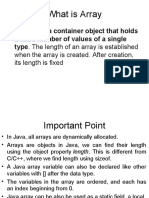0% found this document useful (0 votes)
20 views15 pagesArrays in JAVA
Arrays in Java are fundamental data structures that store multiple values of the same type, functioning as objects with fixed lengths and zero-based indexing. They can hold both primitive types and objects, and are dynamically allocated in memory. Key operations include declaration, initialization, and accessing elements, with support for single-dimensional and multi-dimensional arrays.
Uploaded by
l89856238Copyright
© © All Rights Reserved
We take content rights seriously. If you suspect this is your content, claim it here.
Available Formats
Download as PDF, TXT or read online on Scribd
0% found this document useful (0 votes)
20 views15 pagesArrays in JAVA
Arrays in Java are fundamental data structures that store multiple values of the same type, functioning as objects with fixed lengths and zero-based indexing. They can hold both primitive types and objects, and are dynamically allocated in memory. Key operations include declaration, initialization, and accessing elements, with support for single-dimensional and multi-dimensional arrays.
Uploaded by
l89856238Copyright
© © All Rights Reserved
We take content rights seriously. If you suspect this is your content, claim it here.
Available Formats
Download as PDF, TXT or read online on Scribd
/ 15






















































































